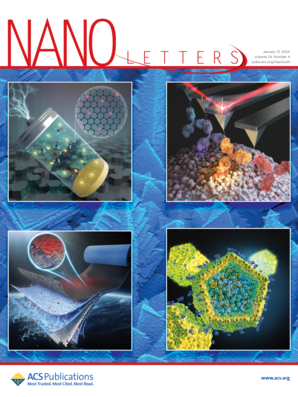cl端多层MXenes向o功能化单层的固体插层和剥离
IF 9.6
1区 材料科学
Q1 CHEMISTRY, MULTIDISCIPLINARY
引用次数: 0
摘要
尽管离子插层正成为在水性或有机体系中生产扩展层状材料和原子层的有力策略,但它通常存在插层时间长达数天的缓慢动力学问题。在这里,我们提出了一种简便的方法,通过在熔盐中固态插层 Cl 端接的手风琴状 MXenes 并随后剥离,制备 O 功能化单层 MXenes。这一过程涉及金属阳离子(Li+、Na+ 和 K+)和阴离子(CO32-)在熔盐中的插层,从而导致 -O 表面基团的取代和气体(CO2)的形成。这种独特的固体插层在 30 分钟内极大地扩展了多层 MXenes,层间距从 11.2 Å 增加到 12.7 Å,使其易于剥离成单层。由此产生的 O 功能化 MXenes 具有高度膨胀的结构和较高的介电常数,在厚度为 1.35 毫米时的电磁波吸收反射损耗值为 -50.5 dB。本文章由计算机程序翻译,如有差异,请以英文原文为准。

Solid Intercalation and Exfoliation of Cl-Terminated Multilayered MXenes toward O-Functionalized Single Layers
Although ion intercalation is becoming a powerful strategy to produce expanded layered materials and atomic layers in aqueous or organic systems, it usually suffers from sluggish kinetics with a long intercalating time of several days. Here, we present a facile approach to produce O-functionalized single-layer MXenes by solid intercalation of Cl-terminated accordion-like MXenes in molten salts and subsequent exfoliation. The process involves the intercalation of metal cations (Li+, Na+ and K+) and anions (CO32–) in molten salts, resulting in substitution with -O surface groups and formation of gases (CO2). Such unique solid intercalation significantly expands multilayered MXenes in 30 min with an enhancement of interlayer spacing from 11.2 to 12.7 Å, facilitating their easy exfoliation to single layers. The resultant O-functionalized MXenes have a highly expanded structure and elevated permittivity, achieving a reflection loss value of −50.5 dB at a thickness of 1.35 mm for electromagnetic wave absorption.
求助全文
通过发布文献求助,成功后即可免费获取论文全文。
去求助
来源期刊

Nano Letters
工程技术-材料科学:综合
CiteScore
16.80
自引率
2.80%
发文量
1182
审稿时长
1.4 months
期刊介绍:
Nano Letters serves as a dynamic platform for promptly disseminating original results in fundamental, applied, and emerging research across all facets of nanoscience and nanotechnology. A pivotal criterion for inclusion within Nano Letters is the convergence of at least two different areas or disciplines, ensuring a rich interdisciplinary scope. The journal is dedicated to fostering exploration in diverse areas, including:
- Experimental and theoretical findings on physical, chemical, and biological phenomena at the nanoscale
- Synthesis, characterization, and processing of organic, inorganic, polymer, and hybrid nanomaterials through physical, chemical, and biological methodologies
- Modeling and simulation of synthetic, assembly, and interaction processes
- Realization of integrated nanostructures and nano-engineered devices exhibiting advanced performance
- Applications of nanoscale materials in living and environmental systems
Nano Letters is committed to advancing and showcasing groundbreaking research that intersects various domains, fostering innovation and collaboration in the ever-evolving field of nanoscience and nanotechnology.
 求助内容:
求助内容: 应助结果提醒方式:
应助结果提醒方式:


